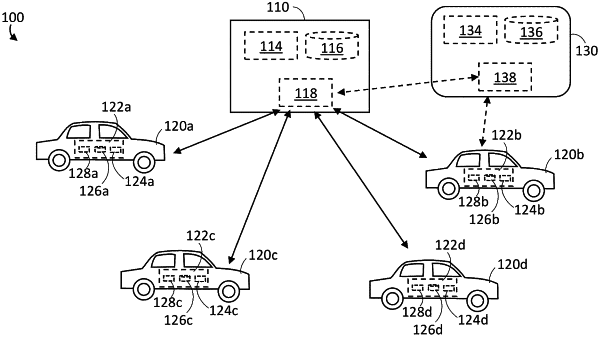| CPC B60R 25/241 (2013.01) [B60R 25/01 (2013.01); G06Q 10/02 (2013.01)] | 15 Claims |

|
1. A vehicle device for managing access to a vehicle, the vehicle device positioned at the vehicle and comprising:
at least one processor; and
at least one non-transitory processor-readable storage medium communicatively coupled to the at least one processor,
wherein the at least one non-transitory processor-readable storage medium stores a first authorization policy including:
a first authentication scheme for authenticating a first access key to use the vehicle in accordance with the first authorization policy;
an indication of at least one first vehicle operation which is permitted under the first authorization policy; and
an indication of at least one first vehicle access requirement to perform each of the at least one first vehicle operation permitted under the first authorization policy,
further wherein the at least one non-transitory processor-readable storage medium further stores a second authorization policy together with the first authorization policy, the second authorization policy different from the first authorization policy, the second authorization policy including:
a second authentication scheme for authenticating a second access key to use the vehicle in accordance with the second authorization policy;
an indication of at least one second vehicle operation which is permitted under the second authorization policy; and
an indication of at least one second vehicle access requirement to perform each of the at least one second vehicle operation permitted under the second authorization policy,
further wherein the at least one non-transitory processor-readable storage medium stores processor-executable instructions which, when executed by the at least one processor, cause the vehicle device to:
receive a user-provided access key from a user;
attempt to authenticate access to the vehicle under the first authorization policy, by the at least one processor, by attempting to authenticate the user-provided access key against the first access key in accordance with the first authentication scheme;
if attempting to authenticate access to the vehicle under the first authorization policy is successful:
receive a user request to perform a user-requested vehicle operation;
determine, by the at least one processor, whether the user-requested vehicle operation is included in the at least one first vehicle operation which is permitted under the first authorization policy;
determine, by the at least one processor, whether a respective at least one first vehicle access requirement to perform the user-requested vehicle operation is met;
if the user-requested vehicle operation is included in the at least one first vehicle operation which is permitted under the first authorization policy, and the respective at least one first vehicle access requirement to perform the user-requested vehicle operation is met, allow the vehicle to perform the user-requested vehicle operation; and
if the user-requested vehicle operation is not included in the at least one first vehicle operation which is permitted under the first authorization policy, or the respective at least one first vehicle access requirement to perform the user-requested vehicle operation is not met, deny the user request to perform the user-requested vehicle operation; and
if attempting to authenticate access to the vehicle under the first authorization policy is not successful:
deny access to the vehicle to the user under the first authorization policy.
|